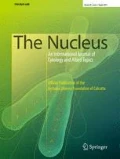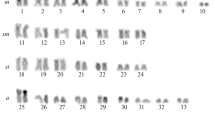Abstract
The genus Pareiorhina, formerly considered monotypic, was recently described to comprise two new species P. carrancas and P. brachyrhyncha. Karyotype analysis allowed to infer cytotaxonomical diagnostic characters for P. rudolphi and P. brachyrhyncha in the present study. The species showed the same diploid number (2n = 54) and karyotypes with 18 m, 32sm, 4st and 18 m, 30sm, 6st chromosomes, respectively. In addition, we found that the nucleolus organizer regions (NORs) are located on different chromosomes. Localization of NORs has been ascertained by fluorescent in situ hybridization (FISH) and colloidal silver nitrate stain (Ag-NORs). P. rudolphi shows NORs in interstitial position of the long arm of chromosome pair number 11, while P. brachyrhyncha shows subterminal NORs only in the short arm of chromosome pair 25. Occurrence of diploid chromosome number and presence of only one pair of NOR bearing chromosomes makes these species to comprised of most plesiomorphic karyotype of Loricariidae and supports its clustering with the genus Neoplecostomus. The chromosome types and diversification in the location of NORs corroborate the description of the species P. brachyrhyncha.



Similar content being viewed by others
References
Alves AL, Oliveira C, Foresti F. Comparative cytogenetics analyses of eleven species of the subfamilies Neoplecostominae and Hypostominae (Siluriformes: Loricariidae). Genetica. 2005;124:127–36.
Andreata AA, Almeida-Toledo LF, Oliveira C, Toledo-Filho S. Cytogenetic studies on the subfamily Hypoptopomatinae (Pisces, Siluriformes, Loricariidae). III. Analysis of seven species. Caryologia. 1994;47:27–37.
Andreata AA, Alves AL, Oliveira C, Foresti F. Hisonotus gibbosus (Teleostei, Loricariidae) segundo Hypoptopomatineo com número diplóide diferente de 54 cromossomos. Genetics and Molecular Biology. 2000; p. 57 (Abstract).
Armbruster JW. Phylogenetic relationships of the suckermouth armored catfishes (Loricariidae) with emphasis on the Hypostominae and the Ancistrinae. Zool J Linn Soc. 2004;141:1–80.
Artoni RF, Bertollo LAC. Nature and distribution of constitutive heterochromatin in fishes, genus Hypostomus (Loricariidae). Genetica. 1999;106:209–14.
Artoni RF, Bertollo LAC. Cytogenetic studies on Hypostominae (Pisces, Siluriformes, Loricariidae). Considerations on karyotype evolution in the genus Hypostomus. Caryologia. 1996;49:81–90.
Artoni RF, Bertollo LAC. Trends in the karyotype evolution of Loricariidae fish (Siluriformes). Hereditas. 2001;134:201–10.
Artoni RF, Terencio M, Vicari MR, Almeida MC, Cestari MM, Bertollo LAC. Cytogenetics of two sympatric Corydoras species (Pisces, Siluriformes, Challichtyidae) of south Brazil. Braz J Biol. 2006;66:191–8.
Bertollo LAC, Born GG, Dergan JA, Fenocchio AS, Moreira-Filho O. A biodiversity approach in the neotropical fish, Hoplias malabaricus. Karyotypic survey, geographic distribution of cytotypes and cytotaxonomic considerations. Chromosome Res. 2000;8:603–13.
Bertollo LAC, Takahashi CS, Moreira-Filho O. Cytotaxonomic considerations on Hoplias lacerdae (Pisces, Erythrinidae). Braz J Genet. 1978;1:103–20.
Bockmann FA, Ribeiro AC. Description of a new suckermouth armored catfish of the genus Pareiorhina (Siluriformes: Loricariidae), from southeastern Brazil. Ichthyol Explor Freshw. 2003;14:231–42.
Borin LA, Martins-Santos IC. Karyotype characterization of three species of genus Trichomycterus (Teleostei, Siluriformes) from Iguaçu river basin. Genetica. 1999;106:215–22.
Centofante L, Bertollo LAC, Buckup PA, Moreira-Filho O. Chromosomal divergence and maintenance of sympatric Characidium fish species (Crenuchidae, Characidiinae). Hereditas. 2003;138:213–8.
Centofante L, Bertollo LAC, Justi AJ, Moreira-Filho O. Correlation of chromosomal and morphologic characters in two Astyanax species. Ichthyol Explor Freshw. 2003;14:361–8.
Centofante L, Bertollo LAC, Moreira-Filho O. A ZZ/ZW sex chromosome system in a new species of the genus Parodon (Parodontidae). Caryologia. 2002;55:139–50.
Chamon CC, Aranda AT, Buckup PA. Pareiorhina brachyrhyncha (Loricariidae, Siluriformes): a new species of fish from the Paraíba do Sul slope of Serra da Mantiqueira, southeastern Brazil. Copeia. 2005:550–558.
Ferraris Jr CJ. Checklist of catfishes, recent and fossil (Osteichthyes: Siluriformes), and catalogue of siluriform primary types. Zootaxa. 2007;1418:1–628.
Garavello JC, Santana IC. Functional Morphology and Geographical Distribution of the Neotropical Catfish Genus Pareiorhina Gosline, 1947 from Southeastern Brazilian Rivers (Pisces, Loricariidae, Hypostominae). In: XXVI Congress of International Association of Theoretical and Applied Limnology, 1998, São Paulo. Verh. Internat. Verein. Limnology, Stuttgart.
Gold JR LIC, Shipley NS, Powers PK. Improved methods for working with fish chromosomes with a review of metaphase chromosome banding. J Fish Biol. 1990;37:563–75.
Hatanaka T, Galetti Jr PM. Mapping of the 18S and 5S ribosomal RNA genes in the fish Prochilodus argenteus Agassiz 1829 (Characiformes, Prochilodontdae). Genetica. 2004;122:239–44.
Howell WM, Black DA. Controlled silver-staining of nucleolus organizer regions with a protective colloidal developer: a l-step method. Experientia. 1980;36:1014–5.
Isbrücker IJH. Classification and catalogue of the mailed Loricariidae (Pisces, Siluriformes). Verslagen en Technische Gegevens, Universiteit van Amsterdam. 1980;22:1–181.
Kantek DLZ, Vicari MR, Cestari MM, Bertollo LAC, Moreira-Filho O. Chromosomal location and distribution of As51 satellite DNA in five species of the genus Astyanax (Teleostei, Characidae, Incertae sedis). J Fish Biol. 2009;75:408–21.
Kavalco KF, Pazza R, Bertollo LAC, Moreira-Filho O. Karyotypic diversity and evolution of Loricariidae (Pisces, Siluriformes). Heredity. 2005;94:180–6.
Levan A, Fredga K, Sandberg AA. Nomenclature for centromeric position on chromosomes. Hereditas. 1964;52:201–20.
Mariotto S, Centofante L, Miyazawa CS, Bertollo LAC, Moreira-Filho O. Chromosome polymorphism in Ancistrus cuiabae Knaack, 1999 (Siluriformes: Loricariidae: Ancistrinae). Neotropical Ichthyol. 2009;7:595–600.
Mariotto S, Miyazawa CS. Ancistrus cf. dubius (Siluriformes, Ancistrinae), a complex of species. 1. Chromosomal characterization of four populations and occurrence of sex chromosomes of the type XX/XY, in the Pantanal Basin of Mato Grosso, Brazil. Caryologia. 2006;59:299–304.
Moreira-Filho O, Galetti Jr PM, Bertollo LAC. Astyanax scabripinnis (Pisces, Characidae): a species complex. Braz J Genet. 1991;14:331–57.
Oliveira C, Almeida-Toledo LF, Mori L, Toledo-Filho SA. Extensive chromosomal rearrangements and nuclear DNA content changes in the evolution of the armoured catfishes genus Corydoras (Pisces, Siluriformes, Callichthyidae). J Fish Biol. 1992;40:419–31.
Oliveira RR, Feldberg E, Dos Anjos MB, Zuanon J. Mechanisms of chromosomal evolution and its possible relation to natural history characteristics in Ancistrus catfishes (Siluriformes, Loricariidae). J Fish Biol. 2009;75:2209–25.
Pinkel D, Straume T, Gray JW. Cytogenetic analysis using quantitative, high-sensitivity, fluorescence hybridization. Proc Natl Acad Sci USA. 1986;83:2934–8.
Reis RE, Pereira EHL, Armbruster JW. Delturinae, a new loricariid catfish subfamily (Teleostei, Siluriformes), with revisions of Delturus and Hemipsilichthys. Zool J Linn Soc. 2006;147:277–99.
Sumner AT. A simple technique for demonstrating centromeric heterocromatin. Exp Cell Res. 1972;75:304–6.
Vicari MR, Moreira-Filho O, Artoni RF, Bertollo LAC. ZZ/ZW sex chromosome system in an undescribed species of the genus Apareiodon (Characiformes, Parodontidae). Cytogenet Genome Res. 2006;114:163–8.
Vicari MR, Noleto RB, Artoni RF, Moreira-Filho O, Bertollo LAC. Comparative cytogenetics among species of the Astyanax scabripinnis complex. Evolutionary and biogeographical inferences. Genet Mol Biol. 2008;31:173–9.
Acknowledgements
The authors are grateful to IBAMA/MMA/SISBIO (Instituto Brasileiro do Meio Ambiente e Recursos Naturais Renováveis) for authorizing the specimens captures. This work was supported by FAPESP (Fundação de Amparo à Pesquisa do Estado de São Paulo), CNPq (Conselho Nacional de Desenvolvimento Científico e Tecnológico, CAPES (Coordenação de Aperfeiçoamento de Pessoal de Nível Superior), FAPEMAT (Fundação de Amparo a Pesquisa do Estado do Mato Grosso) and Fundação Araucária (Fundação Araucária de Apoio ao Desenvolvimento Científico e Tecnológico do Estado do Paraná).
Author information
Authors and Affiliations
Corresponding author
Rights and permissions
About this article
Cite this article
Centofante, L., Vicari, M.R., Artoni, R.F. et al. Chromosome analyses in species of Pareiorhina (Siluriformes, Loricariidae) and cytotaxonomic considerations on the group. Nucleus 54, 65–70 (2011). https://doi.org/10.1007/s13237-011-0035-z
Received:
Published:
Issue Date:
DOI: https://doi.org/10.1007/s13237-011-0035-z




